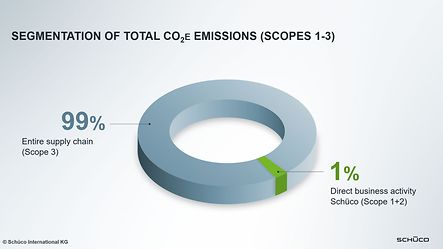
Climate protection
Net zero by 2040
Climate protection is one of the main parts of our sustainability strategy. In partnership with the WWF, we have developed science-based climate protection targets which will help to limit global warming to 1.5 degrees, in line with the Paris Agreement. We are therefore aiming to no longer generate any emissions that are harmful to the environment by 2040. We are calling the accompanying project "Emission Zero".

Ambitious climate targets – backed up by science
We want to achieve our Net Zero target by 2040 and reduce our emissions by 50% by 2030 compared to the reference year 2019. At Schüco, we call the accompanying project "Emission Zero". The basis for our ambitious targets is a neutral carbon footprint across the entire value chain, which we set out in our 2017-2018 sustainability report – as one of the first companies in the construction industry to do so. The aim is therefore not only to reduce our direct emissions within the company, but also to reduce emissions along our upstream and downstream chain. We have submitted the absolute CO2e savings behind the targets to the Science Based Targets initiative (SBTi).
Saving emissions holistically
The savings in CO2 equivalents that Schüco wants to achieve by 2040 relate to three areas, which are known as Scopes. In simple terms, Scope 1 relates to emissions that we ourselves produce through our energy consumption at Schüco. Scope 2 relates to the energy that we use, e.g. electricity that we need for lighting or our IT hardware. Scope 3 is the most challenging area and covers the entire lifecycle of our products. This includes the entire supply chain as well as the fabrication, use and disposal of our products. 99% of emissions fall under Scope 3; 86% of which are purchased goods and services. This means that Schüco has a direct influence over just a very small part of its emissions, and the climate protection targets can only be achieved in very close collaboration with suppliers.


Status quo
In 2022, sales for the Schüco Group rose by 36.7 percent compared to the reference year of 2018, while the absolute GHG emissions were slightly below the reference value from 2018 at -1.3 percent. We are therefore not yet achieving the targets that we set together with the WWF and which were validated as an effective path to reduction by the Science Based Target Initiative (SBTI). Nevertheless, we were able to separate carbon emissions from sales for the first time. The positive trend is reflected in the carbon intensity per million euro of sales, per employee and per tonne of material, which have all reduced compared to the reference year of 2018. However, the development shown cannot be attributed solely to our efforts in procuring low-carbon materials, but is also linked to price and acquisition-related appreciation.
Facing challenges together
We are aware of the enormous potential in the construction industry: environmentally friendly construction is urgently required in order to meet the aims of the Paris Agreement.We want to set a good example with our ambitious climate protection targets and drive forward sustainable development in the industry. In partnership with the WWF, these targets will be turned into concrete measures and firmly anchored in our day-to-day business. As an independent environmental protection organisation, the WWF not only supports the further development and implementation of our measures, it also checks how effective they are. In this way, we can ensure that we are continuing to work purposefully towards a solution.

